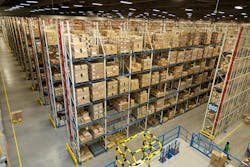Picking Optimization: Cutting Costs and Carbon Footprint in Warehousing
Key Highlights
Picking errors and inefficiency in picking, both inside and outside the warehouse, also ripple out as operational waste. If mistakes aren’t caught in the warehouse, staff must re-pick, re-pack, and ship the correct items
The environmental impact of returns is significant. A recent analysis notes that 20%-30% of online purchases are sent back. E-commerce returns contribute roughly 24 million metric tons of CO₂ each year.
In distribution centers, even small picking mistakes cascade into big problems. For example, one study found DCs lose an average of $585,000 per year to picking mistakes. Broken down, that’s roughly $30 per mis-pick (factoring in the cost of the wrong item, expedited shipping, restocking, and lost sales). Over time, these errors erode profit margins and customer trust.
Picking errors and inefficiency in picking, both inside and outside the warehouse, also ripple out as operational waste. If mistakes aren’t caught in the warehouse, staff must re-pick, re-pack, and ship the correct items. Each unchecked picking error sets off a full cycle of product returns, including extra transportation, handling, and reverse logistics operations. In practice, this means trucks must divert to collect wrong orders or redeliver missed items. In terms of non-optimized routing, it can have the same end results. That’s extra fuel burned, labor hours lost, and vehicles kept on the road.
So how do you beat it? Technology that drives picking accuracy and optimization, slotting that enables the most efficient picking, and tools that can optimize routing on the warehouse floor and speed deliveries on the road.
The customer and environmental toll of returns
Before we offer solutions, let’s dig in a bit on how negatively impactful these inefficiencies can be, to your business and to the environment. Beyond internal costs, errors hurt customer satisfaction. Mispicks lead to more returns, credit notes, and frustrated buyers. One organic food distributor, Veritable Vegetable, reported that cutting their error rate by 40% also reduced customer credits by 60%, evidence that far fewer orders needed correction. Each return or credit isn’t just a paperwork headache; it represents a dissatisfied customer and wasted resources.
Importantly, the broader impact of returns is staggering. Returns are a major driver of reverse logistics in retail and e-commerce. A recent analysis notes that 20–30% of online purchases are sent back. These returns generate a huge carbon penalty: industry-wide, e-commerce returns contribute roughly 24 million metric tons of CO₂ each year. (To put this in context, a single heavy-duty truck emits on the order of 161.8 grams CO₂ per ton-mile, so multiply that by millions of return shipments and the footprint becomes enormous.)
The Reverse Logistics Association says that in the U.S. alone, product returns are estimated to generate 16 million tons of CO₂ annually. Every extra trip – whether a customer mailing back a wrong item or a delivery driver looping back to fix a mis-pick, adds to that total. Reducing picking errors can help shrink the volume of returns and urgent re-deliveries, trimming both costs and emissions. As the CEO of Veritable Vegetable explained, “We don’t have to run our trucks out of the way to pick up something we had misdelivered or make a new delivery, further minimizing our carbon footprint.”
Packaging waste compounds the issue. Each return often involves fresh cartons, labels, and handling materials, which produce more landfill and emissions. Studies show returned goods, even if still sellable, often end up being discarded or liquidated, squandering the embedded carbon and labor already invested.
Customers, workers and companies all see real value
Flipping the conversation to how a proactive strategy can be a significant change, in addition to the success at Veritable Vegetable mentioned above, RNDC, a major beverage distributor, offers yet another data point. After rolling out an optimized picking system, RNDC doubled its bottle-picking productivity and achieved accuracy over 99.6%. The vice president of distribution services highlighted that this level of precision is “imperative” to meet 24-hour delivery promises for hundreds of thousands of orders. Near perfect accuracy means no emergency re-trucks or expedited shipments, saving significant cost and truck emissions each year.
In a related case, a regional beer distributor tackled similar issues. By replacing a paper-based picking process with an optimized system, they went from packing orders by afternoon to finishing sixteen hours earlier. Leadership noted that improved accuracy and efficiency “made us more efficient and effective than ever before,” with customers getting orders on time and employees going home sooner. Those late-night re-picks and extra delivery runs simply vanished.
These examples – spanning organic food, pharmaceuticals, and beverages – underline a consistent trend: better picking accuracy yields both hard savings and sustainability wins. In each case, distribution leaders cited fewer returns/trucks and happier customers as outcomes.
Strategies blending optimization and sustainability
What drives these success stories? Efficient logistics planning and load optimization are key sustainability trends in logistics software. By minimizing the distance traveled and ensuring vehicles are fully loaded, Warehouse automation software can significantly reduce fuel consumption and emissions. This includes warehouse layout optimization, ensuring that goods are stored and retrieved in a manner that minimizes energy use and material handling.
Software can simulate different layout configurations and operational strategies to find the most efficient setup, reducing the distance that workers and machines need to travel. This optimization reduces the environmental impact of logistics operations, contributing to lower greenhouse gas emissions and reduced fuel consumption. Ice cream and frozen foods distributor Jack & Jill moved to improve accuracy and efficiency in their picking and loading processes by moving to an intelligent, voice-directed system. They also wanted to better organize products to make direct store delivery easier and more efficient for drivers.
They achieved a 60% reduction in errors, including zero loading errors. In addition, truck load maps and rack/pallet labelling had downstream benefits, including helping delivery drivers save time at delivery locations.
Other approaches include better slotting (placing fast-moving or similar SKUs in easily distinguishable locations) and audit checkpoints at packing. Crucially, these technologies pay for themselves. With each mis-pick costing tens of dollars (plus lost customer goodwill), the ROI of accuracy tools is clear.
After switching from paper to a digital voice system, Veritable Vegetable not only cut errors, but also halved its paper use, saving 49% of paper (about 23 trees per year), another environmental win.
Training and culture also matter. Clear processes and continuous improvement programs help keep accuracy high. But ultimately, many warehouses find that the combination of data-driven automation and worker-friendly tech makes the difference.
As one manager at humanitarian aid organization Direct Relief put it, “After we went live with [voice picking], a worker told me he had zero numbers spinning through his head – he knew the picking accuracy was there.” With fewer mistakes and less anxiety, everyone from packers to fleet planners benefits.
In today’s logistics landscape, accuracy in order fulfillment is both a profit lever and a green initiative. Reducing picking errors cuts direct costs (fewer refunds, less rework, lower labor expenses) and shrinks the hidden carbon footprint of reverse logistics. By contrast, each mistake compounds waste: needless miles driven, extra packaging, and customer dissatisfaction.
As case studies show, companies that prioritize warehouse accuracy and picking optimization can simultaneously boost their bottom line and make their supply chain more sustainable. In an era of tight margins and climate concerns, that’s a powerful combination – and one well worth the investment.
About the Author

Evan Danis
Evan Danis, Corporate Marketing Manager, Lucas Systems
Danis is a seasoned marketing professional with extensive experience in corporate communications and content management. Currently serving as the Corporate Marketing Manager at Lucas Systems since March 2022, Evan develops targeted advertising strategies and promotional content.
